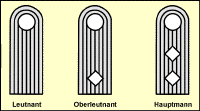Rank, Military Courtesy, and Organization of the Army
Dienstgrad and Gliederung des Heeres
By Erich Tobey--edited by Marsh
The German Army was very formal and "correct"--almost to an extreme. It also had a very rich heritage of traditions. Of course, one of the prerequisites to learning these traditions and customs would be learning about the hierarchy and organization of the military.
Dienstgrad (deenst-grahd) Rank--The primary method of identifying rank was the Schulterklappen (shoulder strap). For men under the rank of Unteroffizier, the straps were plain with only the Waffenfarbe (arm-of service piping) on them, and for Gefreiters, there was a chevron patch in the middle of the left sleeve. For NCOs, a border of Tresse (a type of flat ribbon; early war was generally shiny silver, grey subdued Tresse was introduced later on) was added to the edge of the collar and around the edge of the Schulterklappen. For the various grades of NCOs, the collar Tresse stayed the same, but the pattern on the straps and number of pips varied. For officers, the Tresse was removed from the collar but the Litzen (collar patches) became larger and fancier, with the arm-of-service color in them. The straps were composed of silver braid, and pips were added, just as with the NCO ranks. The reenactor should know the ranks at least up to Hauptmann. The following diagrams illustrate some of the more common ranks:

Sleeve insignia for Mannschaften (Grades of Private)

Unteroffiziere (Non-Commissioned Officers) (shoulderboards)

Offiziere (Company-Grade Officers) (shoulderboards)
Military Courtesy:
As the German Army was so "correct," military courtesy was usually strictly observed. The following are the important elements for the reenactor to learn:
- Address--NCOs are addressed as "Herr" (as in "Herr Unteroffizier," "Herr Feldwebel," etc.). Officers were also addressed in the same manner. (i.e. "Herr Leutnant" or "Herr Hauptmann"). And... it's NEVER "Spieß" or even "Herr Spieß," der Spieß (dair shpees) is ALWAYS addressed as "HERR HAUPTFELDWEBEL!" (hair howpt-felt-vaybell)
- Saluting--In the German army, both officers and Unteroffizier mit Portepee (Feldwebel and above) were saluted. The German hand salute is best described as a "loose" version of the British hand salute, the right hand is brought up closely to the outside, then raised, palm-forward to the visor or cap edge. The outside (heel) of the hand at a very slight angle away from the vertical with the hand loosly together and the arm horizontal to the elbow and angled to the visor. NEVER give the "Hitler Gruß" (Nazi salute).
- Hats, Helmets--Remove caps while indoors unless on duty. The level of preparedness of a German soldier on duty was indicated by his headgear. If he came up to you bareheaded, he probably just wanted to talk. If he came up to you with his cap on (indoors), he is probably on official business. If he came up to you with his helmet on, he means action; perhaps he is there to arrest you, or the outfit is preparing for battle.